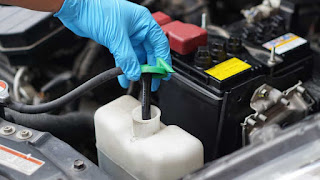RADIATOR COOLANT OVERFLOW TANK WORK
A radiator coolant tank, also known as a coolant reservoir or expansion tank, is an essential component in modern automobiles. It plays a crucial role in the proper functioning of a car's cooling system, which is responsible for preventing the engine from overheating and causing severe damage.
To understand how a coolant overflow tank works, we first need to understand how a car's cooling system functions. The cooling system is designed to circulate coolant, a mixture of water and antifreeze, through the engine block and cylinder head to absorb the heat generated by the combustion process. The heated coolant is then circulated through the radiator, where it is cooled by air passing over the fins of the radiator. Finally, the cooled coolant is returned to the engine to begin the process again.
While the cooling system is operating, the coolant expands and contracts due to changes in temperature. This expansion and contraction create pressure within the system, which can cause coolant to escape through the radiator cap. Additionally, as the engine heats up, the pressure within the cooling system can rise significantly, potentially causing damage to hoses, seals, and other components.
To prevent these issues, a coolant overflow tank is used. The overflow tank is typically made of plastic and is connected to the radiator via a small hose. It is designed to hold excess coolant that is pushed out of the cooling system when the pressure within it rises.
As the coolant in the radiator heats up and expands, it flows into the overflow tank through the small hose. This process occurs as part of a closed-loop system, which allows the coolant to return to the radiator as the engine cools. When the engine is turned off and the coolant cools, it contracts, and the pressure within the cooling system decreases. As this occurs, the vacuum created in the system draws coolant back into the radiator from the overflow tank.
The overflow tank also serves as a visual indicator of the coolant level. Most overflow tanks have a minimum and maximum fill line, allowing the driver or mechanic to check the coolant level easily. If the level is too low, more coolant can be added directly to the overflow tank, preventing the need to open the radiator cap and potentially exposing the system to contaminants.
In addition to preventing coolant loss and maintaining proper pressure within the cooling system, the overflow tank also helps to prevent air pockets from forming within the system. These pockets can cause hot spots within the engine, leading to overheating and potentially causing significant damage.
It's important to note that a malfunctioning overflow tank can cause significant issues within the cooling system. If the tank is cracked or leaking, coolant can escape, leading to a drop in pressure and potential overheating. Additionally, if the overflow tank is overfilled or the hoses are clogged, the system may not function correctly, leading to similar issues.
In conclusion, the radiator coolant overflow tank plays a critical role in the proper functioning of a car's cooling system. By collecting excess coolant, maintaining pressure, and preventing the formation of air pockets, it helps to keep the engine operating at a safe temperature and prevents potentially severe damage. Regular inspection and maintenance of the overflow tank and associated hoses are crucial to ensure that the cooling system functions correctly and to prevent costly repairs.















0 Comments